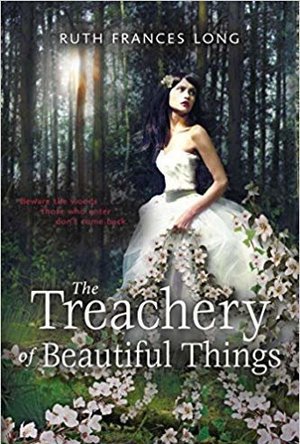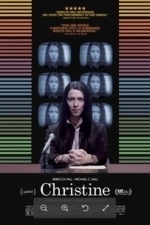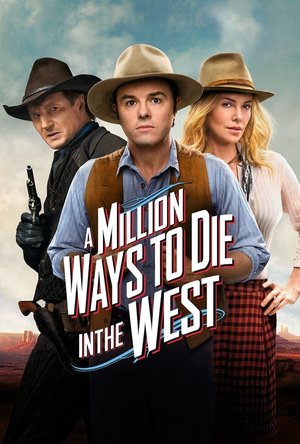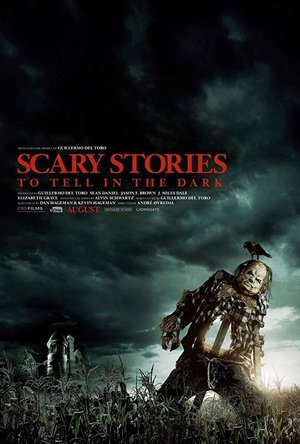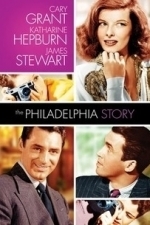Heather Cranmer (2721 KP) rated The Treachery of Beautiful Things in Books
Jun 7, 2018
I had been wanting to read this book since I had first heard about it. I was lucky enough to win it in a blog competition. I'm so glad I did because I loved every second of this book!! It reminded me a little bit like Snow White; not the Disney version but the Grimm's Fairy Tales version.
Jenny is 10 years old when she sees the forest swallow her older brother into the ground. She tries to tell everyone around her that the forest took her brother, but yet, no one believes her. Seven years later, Jenny is walking by the forest when she hears flute music like her brother used to play. Thinking she may be able to find him, she ventures into the very same forest. Little does she know what danger lurks in the forest. Will she be able to save her brother or will she be too late?
The Treachery of Beautiful Things is such a wonderful title for this book! Beautiful things can be dangerous despite their beauty, and how right that is!! The forest is full of beautiful creatures, but not everything is as it seems.
The cover of this book is absolutely gorgeous!! Instead of being just some random picture on the cover, the cover is from a scene in the book, and it fits in beautifully with the title. Well done to the cover artist and the author for choosing this cover. I am entranced by it!
The world building and setting of the forest where the majority of this story takes place is done really well. The author uses great descriptions to make the reader feel as if he/she is a part of it. I easily lost myself in this book and in the forest thanks to the fantastic world building.
The pacing in The Treachery of Beautiful Things is absolutely fantastic! Not once in the story did I feel my attention waning. I was enthralled in the story from the very first page. I reluctantly had to put the book down to do real life things. However, when I had free time, I was devouring this book!
The dialogue is perfect for readers of teen years on up. The dialogue between the characters was very interesting. I especially loved the dialogue between Puck and Jenny.
The author does a great job with character building. I felt the characters were well-developed, and each had their own unique personalities. I loved the character of Jenny. I loved how determined she was to stop at nothing to protect those she loved. Jack was a fantastic character as well. I love how the author made him out to be conflicted but in a believable way. Jack comes across as being a real person instead of a character in a book. Puck was definitely my favourite character by far. He was the one who interjected a lot of humour into this story. I'm thinking the author got the inspiration for Puck from A Midsummer's Night's Dream by Shakespeare. Puck was loyal to a fault to the king, yet he has a heart of gold. Tatania/Mab made an excellent baddie. She reminded me a lot of the queen from Snow White. Oberon was a great baddie as well although he didn't feature as much as Tatania/Mab. We don't learn much about his character until towards the end of the book.
The Treachery of Beautiful Things by Ruth Frances Long is a fantastic story of romance, fairy tale, and suspense. It will keep you wanting more long after you've finished the book.
I'd recommend this book to everyone aged 13+. It's such a lovely read!

Catholic New American Bible Revised Edition
Reference
App
This iPhone/iPad app has been approved by the United States Conference of Catholic Bishops (USCCB). ...

Artemis Director's Viewfinder
Photo & Video and Utilities
App
Artemis Director's Viewfinder reproduces any camera, aspect ratio and lens combination. Included is...

Artemis HD
Photo & Video and Productivity
App
THIS VERSION OF ARTEMIS IS SPECIFICALLY FOR IPAD USERS ONLY. FOR THE UNIVERSAL VERSION OF ARTEMIS...
Bob Mann (459 KP) rated Christine (2016) in Movies
Sep 29, 2021
Christine tells the tragic tale of Florida TV news reporter Christine Chubbuck who committed suicide live on air in 1974. Yes, this is a spoiler, but since most people have some sense of what a film is about before they go to see it, it’s not really a big one. And I think in this case, knowing the outcome is pretty essential since otherwise you will likely spend 2 hours getting increasingly irritated by the erratic behaviour of the lead character and may possibly turn it off. With this movie, the telling is in the journey – not the destination.
London-born Rebecca Hall (“The Town”) plays the 30 year old virgin Christine; a damaged article with past mental issues, she has been moved by her mother Peg (J Smith-Cameron) from Boston to Florida to make a fresh start. But the station is struggling and Christine’s insistence on pursuing dull but worthy stories, such as zoning disputes, isn’t helping: she is driving her boss (Tracy Letts) to distraction. Despite her spiky demeanour and unapproachable nature, her colleagues including Jean (Maria Dizzia), the show’s anchor (and potential deflowerer) George (Michael C Hall) and weatherman Steve (Timothy Simons from “Veep”) all do their best to support her. It is part of the true tragedy of the piece that her downward spiral continues despite their best efforts.
Hall is outstanding in the role. She portrays the crazily compulsive behaviour of Chubbuck extremely well: perfectionism gone wild as she attempts to edit out 3 seconds off a clip while the film is already in the machine. At times the other-worldliness and creepiness of her character become extremely unsettling; an excruciating scene with a married couple in a bar being a case in point. Overall it’s an extremely thoughtful portrayal that is as quiet and unassuming as Ruth Negga’s in “Loving” (but without the smiles or the charm). I would like to think that after the Oscars team picked the ‘obvious contenders’ of Portman, Stone and Huppert, and with a place ‘reserved’ for Streep, they were left with Negga and Hall and had a “dammit, we can only pick 1 out of 2 here” moment.
Letts as the crotchety station chief also delivers a fine performance, and it’s a shame that the script never gave us the chance to see his post-shooting reactions, since the ‘if only’ ramifications for him in particular must have been huge.
In retrospect, Chubbuck’s actions were bizarre: taking her life in such a public way (and insisting the show be recorded for her “reels”) strikes of narcissism and a bitter revenge. While the film is no doubt based on the true recollections of the real-life participants, the screenplay by Craig Shilowich, in an impressive writing debut, for me never quite closed that loop: why this way rather that a car and a hosepipe?
Directed by Antonio Campos, this is never an easy watch. It’s a bit like watching a car crash in ultra-slow motion, and pretty much mandates that you watch an episode of “Father Ted” afterwards to cheer yourself up! But it’s a fascinating study in mental decline, and it’s a useful reminder that it behoves all of us to pay more attention to others around us and reach out with real help if needed before the worst can happen.

Piano with Songs
Music and Games
App
Piano Free has the largest song catalog of any piano on the app store. With over 1,500 songs to...
5 Minute Movie Guy (379 KP) rated A Million Ways to Die in the West (2014) in Movies
Jun 26, 2019
If you’ve ever seen Family Guy, you should feel right at home with the humor in this film. It’s crass, edgy, violent, and full of pop culture references. Although, given that this is an R-rated movie, MacFarlane’s able to push the limits further than usual, and he makes sure to do that by including a lot of raunchy humor and toilet-gags. Oh, and in case you were wondering, yes, male genitals are still the hottest thing in comedy right now. As you’ve no doubt deduced, this is certainly not a film you’d want to take your kids to see. Nor is it for the easily-offended. Though in the film’s defense, it’s not entirely tasteless, and its use of vulgarity isn’t overly frequent. There’s plenty of great slapstick physical comedy and some pretty hilarious dialogue. I laughed more than I thought I would, and was never so disgusted that I wanted to walk out. It’s an entertaining film, it just happens to run a little long and lose momentum down the stretch. Plus the main premise of the film is never all that compelling to begin with.
In A Million Ways to Die in the West, MacFarlane’s character Albert is a man entirely self-aware of the time and place he’s living in, as well as the many dangers that come with it. He sheepishly lives his life, terrified by the threat of death that lurks around every corner. When his beloved girlfriend leaves him for a man with a mighty mustache, Albert has to cowboy up to prove his machismo and try to win her back. Luckily for him, he meets a gun-toting woman named Anna who’s happy to help him face his fears and show him the ropes of being a cowboy. Unfortunately however, this new friendship ends up putting Albert right into the crosshairs of Clinch Leatherwood, the deadliest outlaw around.
While MacFarlane does a respectable job in his first foray into acting, his character feels rather uninspired. I couldn’t help but see him as a hodgepodge of various Family Guy characters, having the clumsiness of Peter Griffin, the self-consciousness of Chris Griffin, and the intelligence and charm of Brian. Given that he created that show, perhaps that should be expected, but it just felt like Albert was lacking a unique and consistent identity. He’s a character who can be charming and funny, but he also comes off seeming like a jerk. All in all, the film has a good cast of actors, with Neil Patrick Harris being the stand-out of the bunch. He plays the pompous, mustached snob, Foy, who steals the heart of Albert’s girlfriend, Louise. Giovanni Ribisi and Sarah Silverman are likable as the flawed, clueless couple who serve as Albert’s close friends, Edward and Ruth. Although their characters stay pretty comfortably within the realm of what you would expect from their respective actors, with Edward being the naïve nice guy, while Silverman’s Ruth is the seemingly-sweet-and-innocent, foul-mouthed hussy. Charlize Theron does a fine job as Albert’s mentor, Anna. She has a strong presence in the film and is fun to watch, but despite her best efforts, the emotional element she brings to the story ends up feeling forced and unconvincing. Though that’s no fault of her own. It’s just hard to imagine her, or anyone, falling head over heels so easily and suddenly for a guy like Albert. Then, of course, there’s Liam Neeson, who is effective in his performance as the intimidating villain, Clinch, but would have benefitted from more screen-time.
A Million Ways to Die in the West proficiently parodies the western film genre, capturing the right atmosphere for the setting and time period. Visually it’s a pleasant film to look at, with good camera-work, well-created sets, and lots of beautiful scenery. This makes it all the more disappointing then that the filmmakers decided to place a visual filter over the entirety of the film to give it a more old-fashioned look. As a result, there is a constant flickering throughout the whole movie, and while not quite seizure-inducing, it certainly is distracting. At times you kind of get used to it and forget about it, but it really stands out in scenes with heavy lighting and most of the movie takes place in broad daylight. On the audio side of things, the music is appropriately fitting, but little of it is particularly noteworthy. There is a great song about mustaches, accompanied with a well-orchestrated dance number led by Neil Patrick Harris in what is undoubtedly one of the highlights of the film. Additionally the film’s theme song is appropriately fun. The visual effects in the movie, although limited, are done quite well and nicely add to the film’s comedic effect. Although I’m sure I speak for everyone when I say the movie could have done just fine without all of the animated urinating sheep.
I think the film’s greatest flaw is the fact that it’s doing too much as it tries to incorporate all of the main stereotypes of the western genre. It has duels, bar brawls, jailbreaks, horse chases, and even capture by Indians thrown in for good measure. In trying to cover all of the bases, the movie ends up running too long and becomes a little boring and tired. Rather than building up to a climax, the film diverges with some unnecessary scenes, and then concludes with a lackluster ending. It would have been cool to see Clinch and his group of bandits lay siege to the main town, which could have given the filmmakers an opportunity to create a wide variety of deaths, and allow Albert to exercise his newly developed skills before setting up to an ultimate final showdown. Maybe that would be adding to the long list of clichés, but at least it would have given this slow-paced film some much needed adrenaline and would have made it more true to its misleading title. There are also several cameo appearances in the film, and while a couple of them are great conceptually, I don’t think any of them are quite as satisfying as they should be. They end up feeling out of place, like last-second additions that have no purpose other than to acknowledge other films. I can appreciate the attempt but the cameos aren’t particularly funny and they just seems to emphasize how much better those other films are.
Seth MacFarlane’s A Million Ways to Die in the West is good for a few laughs, but just like his character Albert’s long-winded ramblings, it feels like it goes on unreasonably long. It’s still an entertaining film regardless, and if you’re a fan of MacFarlane’s other work, you’ll most likely enjoy his parody of the Old West. The movie has a talented cast, some truly great scenes such as a bar brawl and a memorable dance, as well as plenty of good old-fashioned slapstick, and witty dialogue. If you can handle the occasional gross-out gag, you’ll probably have a good time. Just don’t expect to actually see the many ways people can die In the Old West. The movie doesn’t show many deaths at all, and all the best ones you likely already saw in the trailer.
(This review was originally posted at 5mmg.com on 6.3.14.)
Chris Sawin (602 KP) rated Scary Stories to Tell in the Dark (2019) in Movies
Aug 11, 2019 (Updated Aug 11, 2019)
The horror film directed by André Øvredal (Trollhunter, The Autopsy of Jane Doe) follows a group of teenagers in the small town of Mill Valley, Pennsylvania during Halloween in 1968. Stella (Zoe Colletti) is a die-hard fan of the horror genre, Auggie (Gabriel Rush) is a bit too infatuated with girls for his own good, and Chuck (Austin Zajur) lives on candy and pranks when he’s not driving his older sister Ruth (Natalie Ganzhorn) insane. They cross paths with a mysterious drifter named Ramon (Michael Garza) who joins the group seemingly out of boredom.
They initially use trick or treating as a front for revenge against local jock and full-time bully Tommy (Austin Abrams), which leads them to a condemned and rumored to be haunted house of the Bellows family. Sarah Bellows lived in isolation and dramatically killed herself because of her family. Sarah turned her devastating life into inspiration for a series of terrifying stories. After Stella discovers the book Sarah wrote her stories in, strange things begin happening in Mill Valley and everyone in the Bellows house from that night becomes a target.
The monsters of the film attempt to be as explicitly accurate as possible to Stephen Gammell’s original illustrations from the Scary Stories books. This typically pays off, especially with Harold the Scarecrow and The Toe Monster but it seems to backfire with The Pale Lady. While she does still look like a living incarnation of Gammell’s artwork, the story has the weakest conclusion of the entire film. Scary Stories makes up for this by introducing The Jangly Man, who is seriously worth the price of admission alone even if you typically can’t understand a word that he says. The Jangly Man contorts his body in the most inhuman of ways, can separate all of his limbs from his torso, and has this bloodcurdling voice that rattles your insides.
There’s been an emphasis on the lack of a narrative in Scary Stories to Tell in the Dark. That may be true, but the film is based on a trilogy of books that is close to thirty years old and is supposed to be aimed at younger readers. The film adapts the stories in a way that isn’t totally successful, but it is surprisingly great at times. Despite some recognizable names in the supporting cast such as Dean Norris (Breaking Bad), Gil Bellows (The Shawshank Redemption), and Lorraine Toussaint (Orange is the New Black), the main cast is mostly filled with unknowns. Some reviews claim that the acting isn’t up to par, but I was pleasantly surprised. Austin Zajur can be annoying as the mischievous Chuck, but he was also rather humorous the majority of the time. Zoe Colletti goes a little overboard when she cries, but she’s also solid when she gushes over horror. Austin Abrams is seriously nasty as Tommy. He is always sweaty and has no remorse for anyone. He takes bullying to frightening heights.
I guess I expected the film to be corny (pun intended) with lame PG-13 kills and a cast that had no idea what they were doing. The film managed to make me a fan during the Harold segment. That surround sound in the cornfield is masterful with the wind blowing through corn stalks in every direction and the rusty creaking of the scarecrow as he tries to walk. How these teenagers are terrorized manages to transcend what movie ratings typically mean for a given film; this would be unsettling regardless of what it’s rated or how old the viewer is.
Scary Stories to Tell in the Dark is not a perfect horror anthology since it’s extremely simple in concept. A monster shows up, a kid disappears, and then it’s rinse and repeat for an hour and 47 minutes. At the same time though, it’s probably the scariest film of the summer and could potentially become the next big horror franchise. Scary Stories to Tell in the Dark could easily take over where the Final Destination films left off or even be this generation’s answer to that. The practical effects mixed with just the right amount of CGI for the monsters are what really sell the film. Despite being as disjointed and unnatural as The Jangly Man, Scary Stories to Tell in the Dark is way more amusing and eerie than it has any right to be.
BankofMarquis (1832 KP) rated The Philadelphia Story (1940) in Movies
Sep 14, 2019
Recently, I attended our monthly "Secret Movie Night" where we pack the Willow Creek Movie Theater on the 2nd Thursday of every month and get treated to a "Classic" Film (made before 1970) or a "New Classic" (made after 1970), but we don't know what the film is until it starts playing on the screen.
So...imagine how much my eyes rolled back into my head when I saw that this month's film was the aforementioned THE PHILADELPHIA STORY. I sighed to myself and said "all right, time to endure this one all the way through."
And...I couldn't have been more wrong. Almost from the start the script, pacing and witty dialogue of this Broadway-Play-Turned-Movie swept me away. Most certainly aided by the fact that 3 of the best movie stars of all time - at the peak of their abilities - were letting this wonderful dialogue roll off their tongues. This film is a "classic" in every sense of the word.
The plot is...inconsequential. Basically...Philadelphia socialite Tracy Lord (Hepburn) is getting remarried. Her ex-husband (Cary Grant) enlists the aid of a Journalist (Jimmy Stewart) to create havoc at the wedding.
But...this is a film where the journey, not the destination, is the fun of the flick. The 3 leads banter back and forth with each other, arming and disarming (and charming) one another with their quick wit and biting criticism. The Broadway Stage play was written, specifically, for Hepburn and she exceeds in this role. Here is a newsflash - KATHERINE HEPBURN IS A VERY GOOD ACTRESS - and I think this is the very best performance of the very best actress of all time (with apologies to Meryl Streep). She was nominated (but did not win) the Oscar for Best Actress for her performance (losing to a very deserving Ginger Rogers in KITTY FOYLE, I would have voted for Hepburn, but gotta give Rogers her due, she is very good as the titular KITTY FOYLE).
Stepping up to the plate - and matching Hepburn blow for blow - is, surprisingly, Stewart. I didn't really know the story of this film, so I was surprised where Stewart's character-arc went, especially in relation to his relationship with Hepburn. Stewart lost the Oscar in 1939 for his bravura performance in MR. SMITH GOES TO WASHINGTON (inexplicably losing to Robert Donat in GOODBYE MR. CHIPS), so the Academy made up for it's mistake by awarding Stewart the Oscar for Best Actor of 1940. This most certainly was a worthy Oscar-winning performance, but (if I"m going to be honest), pales in comparison to his work in MR. SMITH...
Looming over these two (and Tracy's impeding marriage to another person) is Cary Grant as Tracy's ex-husband, C.K. Dexter Haven. While Grant's role is the least showy of the 3, he commands the screen just with his presence whenever he shows up and strengthens this triangle with his strength of character.
The supporting cast is just as strong - Ruth Hussy (Oscar nominated for Best Supporting Actress) as a photographer, Roland Young (as the lecherous Uncle Willy) and, especially, 13 year old Virginia Weidler who is spunky, fun and smart as Tracy's kid sister. The only performer relegated to the back of the scenery is the bland John Howard as George Kittredge (the man Tracy is slated to marry). With Grant and Stewart on the scene, you know that Kittredge has no shot at getting Tracy Lord to the altar (or does he?).
All of these fine actors and the wonderful dialogue were put into the hands of the great Director George Cukor - who had 1 of his 5 Best Director Oscar Nominations for this film (he will win for MY FAIR LADY in 1964). He handles this film with skilled hands letting the actors (and the dialogue) "do their thing" without letting any of them overstay their welcome. It is a masterful job of directing and with strong actors (and off-screen personalities) like Hepburn, Grant and Stewart, he had his hands full.
Sure...it's a 1940's movie, so some of the "social situations" (mostly male/female dynamics) do not age particularly well, but Hepburn was a strong personality - certainly well ahead of the game in terms of equality of strength of the sexes, so these dynamics do not jump at us as strongly as it might have been in a lesser actress's hands.
If you haven't seen this film in sometime (or if you haven't seen it at all) - check out THE PHILADELPHIA STORY - you'll be glad you did.
Letter Grade: A+
10 (out of 10) stars and you can take that to the Bank(ofMarquis)
Chris Sawin (602 KP) rated Texas Chainsaw Massacre (2022) in Movies
Feb 19, 2022 (Updated Feb 19, 2022)
Dante (Jacob Latimore, Detroit) and Melody (Sarah Yarkin, Happy Death Day 2U) are business partners with somewhat of an impressive internet following. Dante is a chef who is looking to expand and Harlow is just the type of remote town to do it in. Melody’s teenage sister Lila (Elsie Fisher, Eighth Grade) and Dante’s fiancé Ruth (Nell Hudson) have tagged along mostly for emotional support.
With bank investors on the way to scout the location, the young foursome discovers a dilapidated orphanage with an old woman (Alice Krige, Gretel & Hansel) still living inside along with the last of what she refers to as, “her boys.” Dante and his friends awaken the mostly dormant monster known as Leatherface. Sally Hardesty (Olwen Fouéré) has been searching for Leatherface since he killed her friends all those years ago and now she can finally have the vengeful closure that she deserves.
The Texas Chainsaw Massacre franchise is mostly trash. Leatherface has gotten the manure treatment outside of the original film, the 2003 remake, and maybe the 1986 sequel. The timeline is as messy and inconsistent as Halloween as whatever takes place behind the scenes between sequels, remakes, and reboots all seems to result in lackluster or sometimes atrocious outings for one of the most recognizable horror movie icons.
This new film can’t seem to decide what it wants to be. Sally is brought back for a half-hearted cameo as she does nothing but wear a cowboy hat, stare at a picture, cock a shotgun, and gut a pig. She’s meant to be the connection between this film and the original and it just doesn’t work. Texas Chainsaw Massacre also just seems to lift aspects from the original film as well as other non-genre films without ever offering its audience anything original or actually worthwhile.
The ending is basically lifted directly from the original as is the aspect of a group of young people running into trouble on a road trip far away from home. It’s young, city outsiders versus born-and-bred country veterans. The film also has a weird amount of homage to Terminator 2 (Melody’s leg wound and the shotgun blasts to Leatherface by the water being similar to Sarah Connor’s showdown with the T-1000 near the end of T2). It also feels like it’s trying to capitalize on the success Halloween has had since it follows a similar format (making a direct sequel to the original film decades later).
On the bright side, the kills and the gore are mostly satisfying. The wrist breaking scene followed by being stabbed in the neck with the broken bone is gnarly. There’s a brutal head smashing scene with a hammer and the bus sequence is essentially horror movie fan heaven even if the setup and dialogue in said sequence is awful. The swinging door kill feels like it could have been better than it was since it covers up more than it reveals. You can either leave the brutality to the audience’s imagination or show everything in its nasty and gruesome glory; trying to do both in the same sequence just results in disappointment.
You can make the argument that you watch a film like this for the gore and not the story anyway, but that isn’t the point. When there’s this much of a wait between new entries fans deserve better. The frustrating aspect is that Fede Alvarez and Rodo Sayagues are capable of providing a worthwhile story along with the blood and guts because they gave it to us with Evil Dead. There’s nothing here worth the nine year gap between this and the last Texas Chainsaw film (Texas Chainsaw 3D) or the five year gap between this and Leatherface. When it’s not recycling gags from the original film or borrowing from other franchises, it’s just young people being dumb for the sake of a cheap scare or kill.
Texas Chainsaw Massacre isn’t as unwatchable as some reviews are making it out to be, but it’s not a good film by any stretch of the imagination. It’s barely 80-minutes long, so it has a relatively quick pace and the kills are solid. But the story is seriously lacking as there are elements that literally go nowhere; Lila’s backstory about why she’s so quiet doesn’t add much of anything other than a reason for her to never leave a padded cell when and if a sequel to this is ever made.
The problem now is that the successful film formula revolves around nostalgia, rehashing familiar sequences and storylines, and bringing back survivors for one final confrontation. This has all proven to crush the box office, especially during the pandemic. This results in there being no originality or creativity anymore; it’s just a repetition of what we’ve already seen. Until Leatherface can get a fresh face to wear, the Texas Chainsaw Massacre franchise is doomed to run in circles with a sputtering chainsaw on a mostly deserted road no one wants to travel down.
